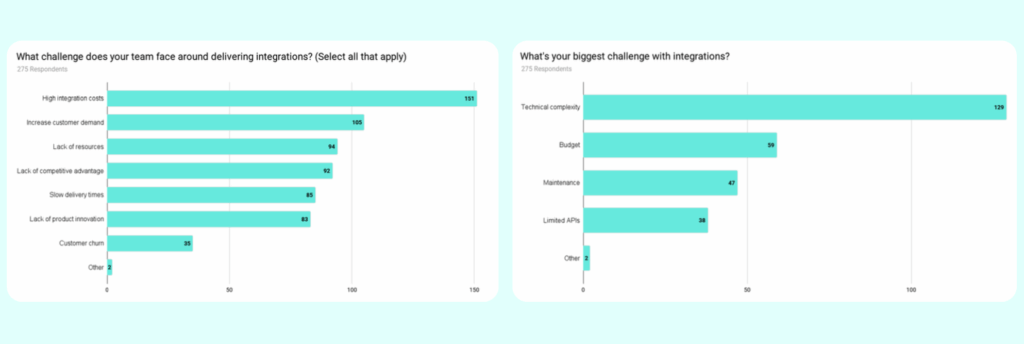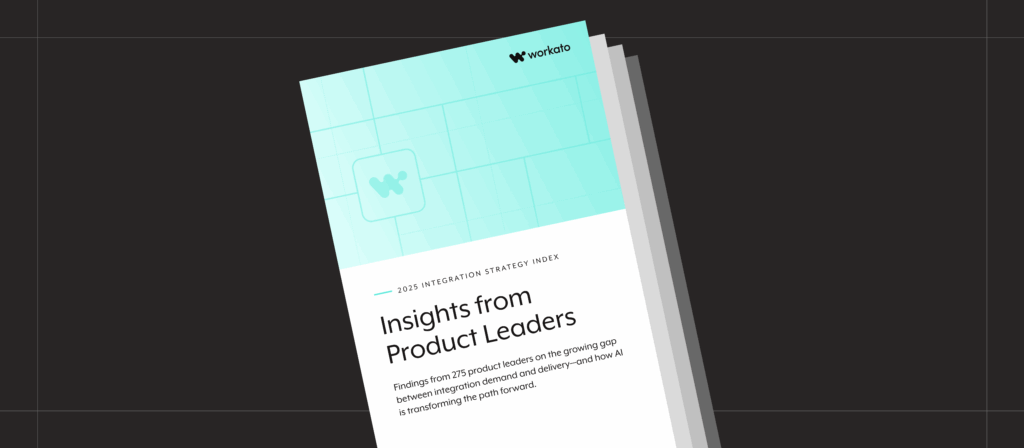Integrations are more critical than ever, but teams are struggling to deliver.
Maybe this sounds all too familiar—maybe it’s even old news in your org. It’s a tension product managers know all too well, and one of the many trends found in the 2025 Integration Strategy Index, the most recent report out of UserEvidence and the Workato Embedded Platform.
We surveyed 275 product leaders at B2B SaaS companies across the United States, Mexico, and Canada on embedded integrations, the impact of AI on their strategies, and how agentic pressure is changing it all.
Here are the top three takeaways and what they mean for your product strategy.
Insight #1: The integration paradox
Everyone knows integrations matter, and the data proves just how much. According to 93% of product leaders, integrations are integral to their product’s success, and 91% said they account for more than a quarter of their product’s value.

But despite their necessity, integrations still aren’t shipping. Only one in 10 companies successfully implemented more than 75% of their planned integrations within a year.
This means 90% of product teams are leaving the majority of integrations on the table. AKA, the capabilities that drive 25% or more of product value.
What does this mean?
Integrations are both a massive opportunity and a major pain point. They’re not a “nice-to-have”—they’re business-critical. And yet, backlogs keep growing.
While this hurts product and engineering teams, the implications ripple outward. The ones who actually suffer in this scenario are your customers. For example, if an integration is promised during the sales cycle and six months later it’s still not shipped, that customer is likely evaluating competitors.
This translates into lower satisfaction, higher churn risk, and a weakened competitive positioning. But if everyone agrees integrations are critical, what’s actually holding teams back?
Insight #2: Budget’s not the problem
While it may be tempting to throw money at the problem, in this case, it’s already there.
Don’t get us wrong, when asked about general pain points, cost was mentioned across the board. But when we asked product leaders to identify their single biggest challenge, the story changed dramatically. Technical complexity led the pack at 47%, while cost concerns dropped by more than half to just 21%.

Even more telling: nearly 80% of companies already spend more than a quarter of their development budgets on integrations. These aren’t under-resourced teams—they’re well-funded and hitting a wall that money can’t solve.
What does this mean?
Money isn’t the problem or the solution. Having more engineers on the job won’t fix the 3.5-month development cycles the average product team is facing.
Teams are investing heavily but still can’t keep up in the way of technical skill, architecture, and tooling. Legacy systems, inconsistent APIs, and the reality that each integration is essentially a custom build with no economies of scale—that’s what’s actually slowing teams down. And while teams believe they’ve found the answer in AI, it’s far from a silver bullet.
Insight #3: AI’s double-edged sword
Just about everyone is trying to take a slice of the AI pie for their product’s gain.
We found an overwhelming 99% expect AI to play a role in their integration strategy, and nearly three-quarters already express high trust in AI solutions. And when it comes to agentic AI—which can execute workflows and make decisions—98% have explored or plan to implement it.

But there’s a catch: AI is only as strong as the connectivity beneath it. The same technical complexity, budget constraints, and security concerns that plague traditional integrations remain the top barriers to AI adoption.
So if you’re working with unreliable API connections, inconsistent data mapping, or brittle integrations, bringing AI into the mix will just make things worse, turning manual fixes into compounding automated failures. However, with well-architected integrations, consistent data flows, and reliable connectivity, AI has the opposite effect—autonomously orchestrating workflows across systems and strengthening the foundation you’ve already built.
This is AI’s double-edged sword: it amplifies what already exists. It makes what works work even better, and deepens any foundational cracks.
What does this mean?
Strong connectivity infrastructure is the prerequisite for AI success. Companies betting on AI without solving integration complexity first may find themselves disappointed. Or worse, creating new problems faster than they solve old ones.
Your roadmap to agentic success
These three insights reveal a pattern: there’s a widening gap between integration importance and execution capability.
Teams that crack the code on technical complexity and connectivity will dominate their markets in the agentic era. And the Integration Strategy Index is the roadmap to drive you forward.
Access the full report for more key insights. Plus, discover which integrations customers request most and how top-performing teams are measuring agentic success.

Download the 2025 Integration Strategy Index
Ready to take your integration strategy to the next level?
